Guqin Part 3: Tablature Old and New
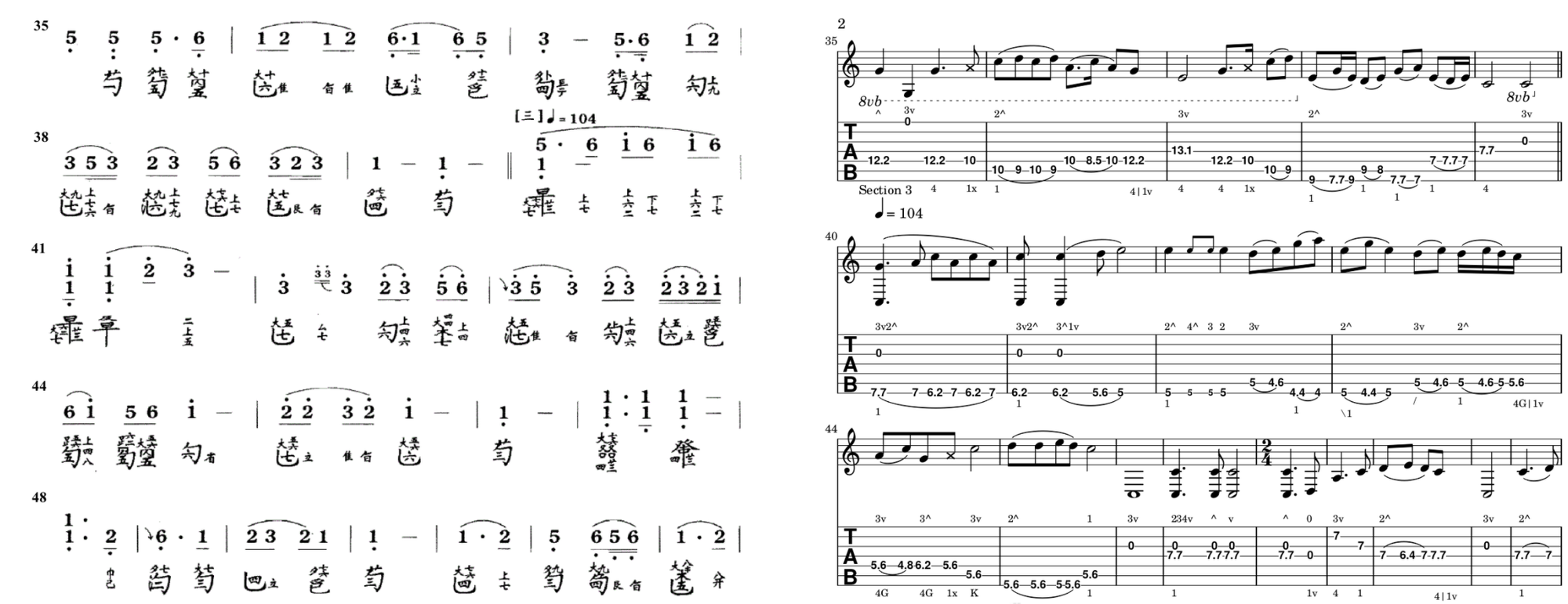
Now that we've figured out where to press or touch to play notes (Part 1: Harmonics and Hui Positions , Guqin Part 2: Open & Pressed Notes), we need to figure out how to jot down music.
1: The Old Way, Jianzipu (减字谱)
Traditionally, Guqin music is written in characters that represent how to interact with the strings. This is unlike western music, where the notation is on the note and the rhythm, and an occasional hint at how to move the fingers. In Guqin music, there's no rhythm (or very little) rhythm indication. In this sense, it's a bit like poetry, where we are given the words but there's no instructions on how fast or slow to read the poem.
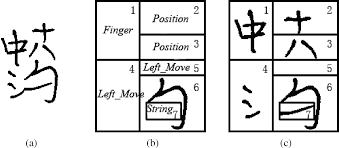
The diagram above deconstruct a "note" in traditional Guqin notation. Actually, the system here is simplified Guqin notation, Jianzipu, which was developed in the Ming Dynasty. Prior to that, each part of this "character" would be written out. Quite a lengthy process to describe one "note." In this example, the different parts of the character show us how to play the note: slide down (box 4) with the left middle finger (box 1) towards 7.8 (box 2 and box 3), while plucking inwards with the right middle finger (box 6) on the first string (box 7).
Here's the first few lines of my favorite pieces, Plane Leaves Dancing in the Autumn Wind, in Jianzipu.

This is actually a pretty cool system. Using a small space, the character packs in so much information. However, there are a few problems I have:
- How to write this? I can't really note down these things on the computer. There's not software I could find (ideally free / open source) that I can use. I can't just open up my Chinese keyboard and create new characters since these are not actually Chinese characters.
- Learning curve: It takes a while to learn. There are just so much to memorize. The symbols from plucking inward, outward, different combinations of inward and outward plugging all have different characters to memorize.
- Excess instructions: Sometimes I don't actually want to note down which finger to use and with which technique. In piano, not every note gets a finger assignment. Some notes have obvious fingering, others is up to the artist to interpret. I'm more used to that kind of system.
- Awkward multi-voice support: It doesn't really support multiple voices. Most Guqin music has only one voice, the melody. But with a Guqin, there are more than just one string, and that means we can do stuff with all those unused strings for each note. Counterpoint? Accompaniment? So many possibilities.
Mini Sidebar 1: I am not a professional Guqin player, or a professional musician. I am not trying to convince the world of a newfangled way of doing something. I simply need to solve some of these problems so I can quickly jot down new musical ideas and have an aid in helping me learn more pieces. Actually, as a non professional who is not trying to upend the establishment, I find I actually have more freedom to do what I want, and freedom is an essential ingredient in invention. If there are others out there who have similar problems, maybe these solutions might be helpful to you too. Or maybe there are problems that I overlooked that we can solve together. Either way, drop me a line and let's chat.
Mini Sidebar 2: I am not listing another common complaint for Jianzipu, which is the lack of rhythmic indicators and meter (e.g., this note should be twice as long as this note). I've always thought about Guqin music as more like poetry, and nobody gives Shakespeare any grief about how specifying how long an actor should pause before a certain word. Even in classical piano music, I've always gravitated more to periods where rhythm is a bit more up to the artist's interpretation in where they speed up and hold back. I find that more interesting, so the lack of rhythm does not bother me as much in Jianzipu.
Mini Sidebar 3: It's possible that I'm not proposing anything new here. I look around the internet (albeit in English), and did not find any alternatives to Jianzipu, but maybe I was not looking into the right places. If an alternative system exist, please let me know.
Anyway, I started experimenting with different ways of writing notes to solve these problems. At first, I tried to use the QWERTY keyboard to approximate the Guqin tablature. I ended up with gibberish like "5|4v|3_1/" which is not user-friendly. One morning, as I was walking my dog, it came to me (as many ideas do during these walks) to look to notations other instruments used. And I realized I just found a path that just might work.
2: The New Way, Number on Line Tablature
"Good designers copy, great designers steal."
– Picasso(ish)
Modern guitar uses a tab system where the numbers, representing frets, are written on lines, representing strings. So a number 1 on the third line, means we press down on the 1st fret on the third string. This is visually easy to understand. Glancing at it, we can visually see the order in which to pluck the strings, and browsing the numbers gives us a sense of how to move the fingers up and down the string.
Because "tablature" simply means a system to communicate where to place the finger, it can technically also apply to Jianzipu. To differentiate, I will say Jianzipu when I'm referring to the character based tabs system, and I will say Number on Line Tablature or NLTabs when referring to the guitar tabs system.
Remember that snippet of the Plane Leaves Dancing in the Autumn Wind? Here it is in NLTabs form:
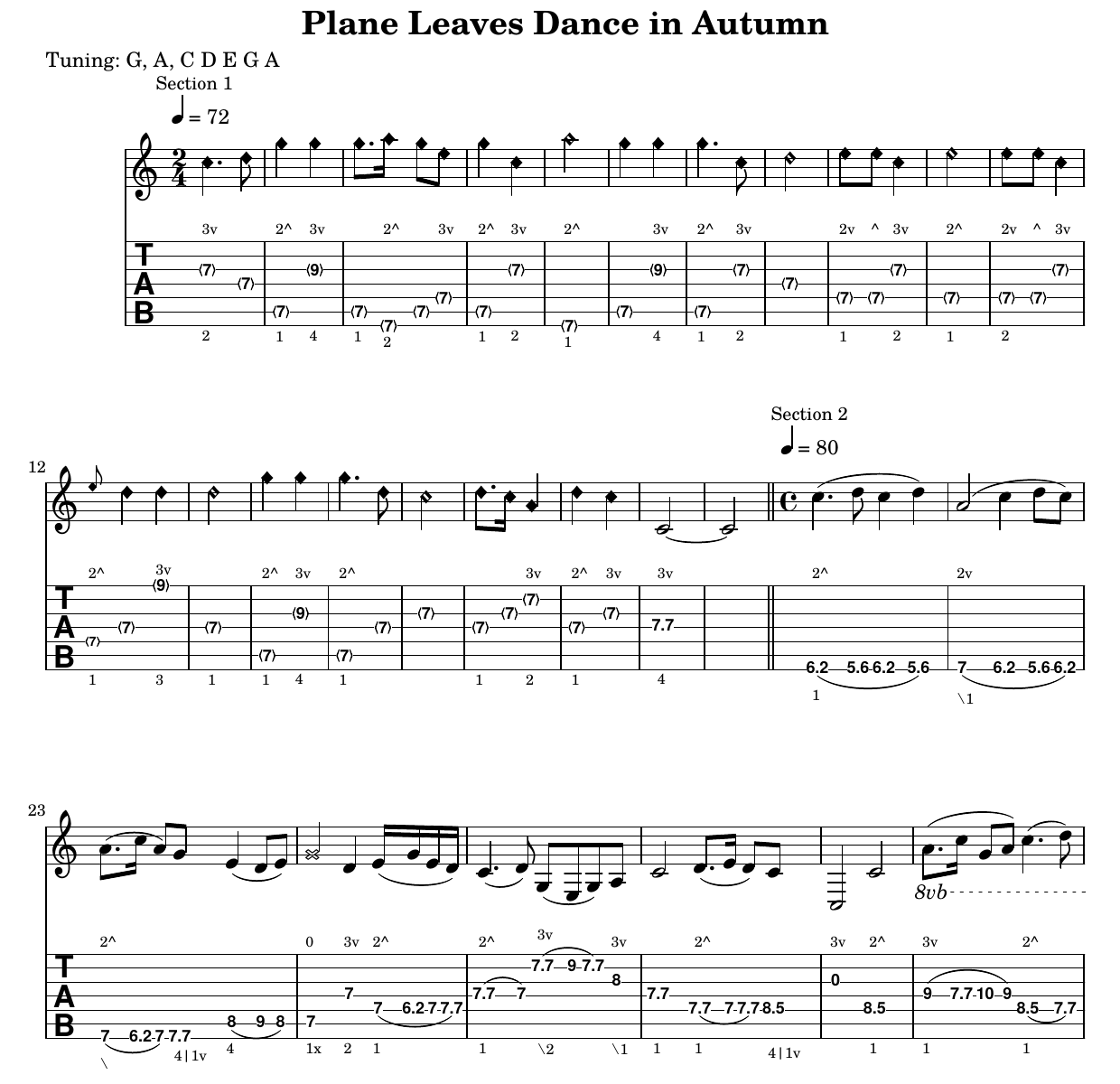
And what else is nifty about NLTabs? We can use any ASCII text editor! 🙌🏻
<d'8. c'16 a d'4 c'4> c1 (c'4. d'8 c'4 d) (a2 c'4 d'8 c')
3v 2^ 2v
G----------------------|-----|-------------------|----------------------
A-----------<7>--------|-----|-------------------|----------------------
C-------<7>--------<7>-|-----|-------------------|----------------------
D-<7>----------<7>-----|-4.4-|-------------------|----------------------
E----------------------|-----|-------------------|----------------------
G----------------------|-----|-------------------|----------------------
A----------------------|-----|-(6.2-5.6-6.2-5.6)-|-(7--6.2---5.6---6.2)-
4 \2.1: The Basics
- Hui Positions: The numbers represent where to touch the string, using the hui positions. So
6.2is between 6th and 7th hui, but closer to the 6th hui. There are 7 strings on the NLTabs staff, with the upper most string corresponding to the string furthest away from the Guqin player.0means the open string is plucked. - Harmonics: the hui positions are in
<#>with the diamond notes represent harmonics. This is lightly touching the string with the left hand and plucking with the right. - Right v. Left Hand: Right Hand fingering is above the tabs, left hand fingering is below the tabs
- Finger Numbers: Finger numbers follow the rules in piano: thumb is
1, index finger is2, middle is3, ring is4, and pinky is5. This is how I'm used to reading finger markings on the piano. In addition,1Kor4Kindicates that we use the side knuckle area of these fingers, and4Gindicates we should play with the knuckle below the nail of the ring finger, the Guì 跪 position.
Some edge cases:
- String Number: This should not be needed, since it should be obvious which string is used in NLTabs. For chords that are plucked, I also use the convention the left most fingering represents the lowest string number. But if needed, I use
{5}to indicate String 5 (this happens if both the left and the right hand plucks to play chords, so we'll need an indicator to tell us which hand should pluck which string). - Pipes: I use pipes, the
|symbol, to separate out fingerings that should happen together.
Not every note needs to be annotated. I like to leave out some that I think are pretty obvious. This is similar to how piano sheet music treats fingering notations, where the notations are suggestions for how to tackle tricky passages or clever fingerings. In Guqin music, one can argue that the fingering are key to the music, since each finger elicits a different sound. But, I consider all that in the realm of the artist's interpretation of the piece.
2.2: Left Handed Notations
- Slides: (ex:
(1 /)) slides are represented with parentheses. In these cases, just slide the left hand while pressing on the string, but don't need to pluck. - Slide into a note (ex:
\or/): pluck a bit lower or higher than the intended note and slide into it. - Left handed pluck (ex:
4|1v): press down with the 4th finger and pluck with the left hand instead of the right - Left handed mute (ex:
1X): mute the string with the 1st finger - Vibrato (ex:
~): use a vibrato on the note (not in the example above) - Fast and Slow (ex:
>for fast,<for slow): This can be added to indicate how fast a vibrato or slide should be.
2.3: Right Handed Notations
- Pluck outwards (ex:
2^): index finger to pluck outwards, away from the player - Pluck inwards (ex:
2v): theindex finger to pluck towards the player's body - No plucking (ex:
0): this is to reinforce that the right hand doesn't need to do anything to draw out this note - Pluck in unison (ex:
[234]vor234v): The brackets emphasize that the pluck is in unison, though a 234v under one note as opposed to grace notes would indicate that it's in unison. - Pluck in quick succession (ex:
4,3,2^or4^,3,2or432^): The commas indicate that we pluck the strings in rapid succession. Though use of grace notes in the staff can also indicate that the notes should be plucked quickly. - Glissando (ex:
$): pluck a bunch of strings in quick succession.
By combining these handful of symbols, I was able to write all (or at least all that I've checked) of the techniques listed on PeiYouQin's website in NLTabs.
3: NLTabs Glossary
Ok, I admit. I got a little carried away here. A few reasons though: (1) I wanted to make sure the NLTab system can cover all the different playing techniques (2) I had a bit of fun learning the ins and outs of LilyPond, which I used to engrave the music and (3) I wanted a solid reference for Guqin techniques at my disposal for when I write or learn music in the future. So, I ended up annotating most of the Guqin playing techniques on PeiYouQin's website, which has been my go to for playing technique references. As an added bonus, (4) it was a good refresher to all those characters in my Guqin books.
REFERENCE: The images below are stored here, Guqin NLTabs Glossary on LilyBin (the Chinese characters do not show up in LilyBin).
3.1: Basic Note Types
Fàn Yīn 泛音 or Harmonics
Lightly touch the hui (Huī 徽) position with left hand, and pluck with right. Fan Yin's hui positions are noted in the tab with enclosed brackets <>.

a'4 a' a' a' <-- this is based on LilyPond's notation
G-------------------|
A-------------------|
C-------------------|
D-------<9>-----<5>-|
E-------------------|
G-------------------|
A--<7>---- -<7>-----|Sàn Yīn 散音 or Open String
Do nothing with left hand and pluck with the right hand. San Yin's hui positions are noted as 0s.

g,8 a, c d e f g
G---0-------------------|
A------0----------------|
C---------0-------------|
D------------0----------|
E---------------0-------|
G------------------0----|
A---------------------0-|Àn Yīn 按音 or Pressed Notes / Fundamental tones
Press down on the string at the hui position specified in the tab and pluck with the right hand

c8 c c c c c c
4
G---5.6-----------------------|
A-------6.2-------------------|
C-----------7-----------------|
D--------------7.7------------|
E------------------8.5--------|
G----------------------10-----|
A-------------------------12.2|3.2: Right Handed Techniques
Right Hand Gets Plucky
I use 1-5 to represent thumb, index, middle, ring, and pinky. v represents plucking
inwards, and ^ represents plucking outwards. Example below:
Measure 1
- Note 1: Bō 托: Pluck with thumb (1) inwards towards the body (v)
- 2: Pī 劈: Pluck with thumb (1) outwards away from the body (^)
- 3: Mǒ 抹
- 4: Tiāo 挑
Measure 2
- Gōu 勾
- Tī 剔
- Dă 打
- Zhāi 摘

a,4
1v 1^ 2v 2^ 3v 3^ 4v 4^
G-----------------|---------------|
A-----------------|---------------|
C-----------------|---------------|
D-----------------|---------------|
E-----------------|---------------|
G-----------------|---------------|
A---0---0---0---0-|--0---0---0---0|Persisting Instructions
If there is no number or a plucking direction, assume that the previous note's instruction persists. Examples:
- Measure 1: use the second finger to pluck all 4 notes inwards.
- Measure 2: use the an outward position on all 3 notes
- Measure 3: use the same finger on all 4 notes

d4 e g a a a a2 a4 a a a
2v 4^ 3 2 3^ v ^ v
G-----------------|---------------|---------------|
A-----------------|---------------|---------------|
C-----------------|---------------|---------------|
D--0--------------|---------------|---------------|
E------0----------|---------------|---------------|
G-----------0-----|---------------|---------------|
A---------------0-|-0---0---0-----|-0---0---0---0-|Quick repetitive notes (Lún 轮)
Pluck the same string in rapid succession.Here's a few different ways to write it. Commas between each finger emphasizes that each finger in this order should pluck in rapid succession, and not in unison. That said, there are grace notes, that kind of gives a hint that the notes should be played in rapid succession, hence the commas could be optional here.

*a, *a a4 *a *a a2 *a *a a4
4,3,2^ 4^ 3 2 432^
G-----------------------------------------|
A-----------------------------------------|
C-----------------------------------------|
D-----------------------------------------|
E-----------------------------------------|
G-----------------------------------------|
A---*0-*0--0-------*0-*0--0---*0-*0--0----|Chords One Way (Bō 拨, Lá 剌, etc.)
- Measure 1, Note 1 & 2: Bō 拨: which is plucking the chord (both strings) with multiple fingers inwards in unison. These are different ways to note Bo in tabs. Since there's chord in the staff and in the tab, it should be obvious to play these notes in unison. Hence 234v should also suffice.
- Measure 1, Note 3: I suppose with the tab notation, we can use any finger combos. For example, in the last note, pluck with only 2nd and 3rd finger.
- Measure 2, Note 1: Lá (or Cì) 剌: pluck the note with multiple fingers,
but pluck outwards - Measure 2, Note 2 & 3: Bō Lá 拨剌: Fingers 234, pluck both notes inwards then outwards

<c e>4 <c e> <c e>2 <c e>4 <c e> <c e>2
[234]v 234v 23v 234^ 234v ^
G-----------------------|----------------------|
A-----------------------|----------------------|
C-----------------------|----------------------|
D-----------------------|----------------------|
E-----------------------|----------------------|
G----10-----10-----10---|---10-----10-----10---|
A----0------0------0----|---0------0------0----|Chords Another Way (Cuō 撮 & Dà Cuō 大撮)
- First note is a Cuō 撮: pluck both strings to form the chord. With chords, the first finger notation (3v in this example) applies to the lowest string, which is the E on String 5 in this example. In this case, pluck open string 5 (E) with 3rd finger inwards, and open string 7 (A) with 2nd finger outwards.
- Second note is a Dà Cuō 大撮 (second note): this follows the same principle, but different strings and different fingering. Here, pluck string 3 (C) with 3rd finger inwards and string 7 (A) with the first finger outwards.

<e, a,>2 <c, a,>2
3v|2^ 3v|1^
G-----------------------------------------|
A-----------------------------------------|
C-----------------0-----------------------|
D-----------------------------------------|
E-----0-----------------------------------|
G-----------------------------------------|
A-----0-----------0-----------------------|Glissandos (Gǔn 滾, Fú 拂, etc.)
Here are some examples of glissandos. The ripply lines represent plucking all the strings! Examples:
- Note 1: The first chord should be quickly pluck from the bottom note to the top note
- Note 2: Second note is a Fú 拂: A slower glissando, which takes around a quarter note length from string 1 to 7.
- The last run in the first measure shows yet another to achieve a Fú 拂 is to write out the notes
- Measure 2: This shows a Gǔn Fú 滾拂: takes around a quarter note length to go from string 1 to 7, then another quarter note length to go back down to string 1.

g,~>a4 g,4~>a g,4~>a a4~> g,4~>a
2v 2v 2v 4^ 2v
G---$-----$-------$--------------0--------|
A---$------$-------$------------$-$-------|
C---$-------$-------$----------$---$------|
D---$--------$-------$--------$-----$-----|
E---$---------$-------$------$-------$----|
G---$----------$-------$----$---------$---|
A---0-----------0-------0--0----------*0--|3.3: Left Handed Techniques
Left Handed Fingering
Like the right hand, I use 1-5 to represent thumb, index, middle, ring, and pinky.
I also use K to represent the outside knuckle, and G to represent the knuckle right
underneath the nail (Guì 跪). For left handed fingering positions, the comments are written under the tabs:
- 1: Dà Zhǐ 大指: Thumb presses down on the string
- 1K: Thumb's knuckle
- 2: Shí Zhǐ 食指, index finger
- 3: Zhōng Zhǐ 中指, middle finger
- 4: Míng Zhǐ 名指, ring finger
- 4K: Ring finger's outside knuckle
- 4G; Guì 跪: Ring finger's knuckle underneath the nail

c4 d c c c d g'2
G-----------------|---------------|
A-----------------|---------------|
C-----------------|---------------|
D-----------------|---------------|
E-----------------|---------------|
G--10------10--10-|--10-----------|
A------10---------|------10---4.4-|Vibratos (Yín 吟, Náo 猱, etc.)
Here are some examples of vibrato. The number of ~ represent how much to vibrato, and < and > represents slowly and quickly, respectively. I suppose >> can represent vibratoing super quickly. An equal sign = before the ~ represent that the finger doesn't move. Examples:
Measure 1:
- Note 1: Yín 吟: normal vibrato
- 2: Náo 猱: stronger vibrato
- 3: Xì Yín 細吟: weaker vibrato
- 4: Dìng Yín 定吟: vibrato with wrist only, don't move the finger
Measure 2
- Note 1: Yóu Yín 游吟: slow vibrato
- 2: Jí Náo 急猱: fast vibrato

c4 c c c c2 c2
G----------------------|-------------------|
A----------------------|-------------------|
C----------------------|-------------------|
D----------------------|-------------------|
E----------------------|-------------------|
G----------------------|-------------------|
A--10---10----10--10---|-10------10--------|
1~~ 1~~~ 1~ 1=~~ 1<~~ 1>~~~Sliding into a Note (Chuò 绰, Zhù 注, etc.)
The slashes represents sliding down (\) or up (/)to the note. Examples:
- Note 1: Chuò 绰
- 2: Zhù 注
- 3: Chuò 绰, then Yín 吟 (combining slides w/ vibratos)
- 4: Zhù 注, then Náo 猱 (another example of combining slides w/ vibratos)

a4 a a a
G------------------|
A------------------|
C------------------|
D------------------|
E------------------|
G------------------|
A--7---7---7---7---|
/1 \1 /1~ \1~~ Slide Notation Variations
These are different ways to note slides. Slurs over the notes represents slides. The most specific way is to put parentheses around the notes that slide, so in each of these note pairs, the right hand only plucks the first note. Putting a 0 above the staff emphasizes that the right hand does nothing. Though here, the 0 is a bit superfluous since the slurs should indicate that the right hand chills out. The slurs also makes the parentheses unnecessary, so the second pair is fine too. Last, the fact that the second note's hui position is higher than the first should make it unnecessary to add an upper slash, indicating sliding up. The simplest finger notation is the last pair, which I prefer.

(a8 c'4.) (a8 c'4.) (a8 c'4.) (a8 c'4.)
G------------------------|--------------------------|
A------------------------|--------------------------|
C------------------------|--------------------------|
D------------------------|--------------------------|
E------------------------|--------------------------|
G------------------------|--------------------------|
A--(7---6.2)---(7---6.2)-|--(7---6.2)----(7---6.2)--|
(1 /1 ) 1 / (1 ) 1 More Slides (Shàng 上, Xià 下, Tǎng 淌, Tuō 拖)
- Shàng 上
- Xià 下
- Tǎng 淌: the < indicate that the slide down should be slow, as does the fact
that the first note in this pair has a quarter note length. - Tuō (or Tuō Shàng) 拖, slow

(a8 c'4.) (a8 c'4.) (a4 c') (a c')
G------------------------|--------------------------|
A------------------------|--------------------------|
C------------------------|--------------------------|
D------------------------|--------------------------|
E------------------------|--------------------------|
G------------------------|--------------------------|
A--(7---6.2)---(6.2--7-)-|-(6.2---7)---(7---6.2)----|
1 / 1 1 < / 1 <Bends (Zhuàng 撞, Dòu 逗, etc.)
These notes represent a one-time vibrato. Notes that bend up and
down, or down and up once. Examples:
First measure:
- Zhuàng 撞
- Dòu 逗: quickly bend up and down, same time as plucking
- Shuāng Zhuàng 双撞: bend up&down twice at tied notes
Second measure:
- Xū Zhuàng 虛撞: slide up, then bend up&down
- Fǎn Zhuàng 反撞: this is the last set of A notes, bend down and then up.

a4 a4 a4==a8=a8 (a8 c'==c4) a==a
G------------------------|---------------------|
A------------------------|---------------------|
C------------------------|---------------------|
D------------------------|---------------------|
E------------------------|---------------------|
G------------------------|---------------------|
A--7---7----7------------|-(7---6.2---)--7-----|
1/\ 1>/\ 1 /\ /\ 1 / /\ 1 \/= to represent tied notes up topLeft Hand Gets Plucky (Qiā Qǐ 掐起, Zhuā Qĭ 抓起, Tuī Chū 推出)
These notes are plucked with the left hand. Similar to the right hand, we use ^ = to represent plucking outwards, and v to represent plucking inwards.
The pipe line, |, means press down with the finger to the left and Pluck
with the finger to the right. Examples:
- Qiā Qǐ 掐起: last note of the first measure represents this, where finger 4 holds a 12.2 hui and left hand's finger 1 plucks inwards
- Zhuā Qĭ 抓起: slide down and pluck with the left hand's thumb inwards
- Tuī Chū 推出: the first note is played with the left hand's finger 3 holding down on hui 7 position, the second note is played by the left hand's finger 3 plucking outwards.

(a4. c'8 a4) g a4 a4 a4 a4
G---------------------|---------|---------|
A---------------------|---------|---------|
C---------------------|---------|---------|
D---------------------|---------|---------|
E-(10.8--5-10.2)-12.2-|---------|---------|
G---------------------|---------|---------|
A---------------------|-7----7--|-7-----7-|
1 4|1v \1 1v 3 ^Finger Mutes (Yǎn 罨 and Xū Yǎn 虛罨)
- Yǎn 罨 (to cover): the last note in the first measure, the thumb mutes at hui 7.
- Xū Yǎn 虛罨: the middle finger mutes at hui 7.

(e4 d8 e) xg2 xg1
G-------------------|------|
A-------------------|------|
C-------------------|------|
D-------------------|------|
E-------------------|------|
G-(8---9--8)---7----|--7---|
A-------------------|------|
4 1X 3XSliding Into a Chord (Yīng Hé 应合)
These are special "chords"... short of. The first note is plucked at 11 Hui (3rd string), then it slides up to 9 Hui while the 6th string is plucked.

(e2 g2)
G-------------|
A-------------|
C--(11-----9)-|
D-------------|
E-------------|
G----------0--|
A-------------|Sustaining Into a Chord (Tóng Shēng 同声 / Dài Hé 帶合)
The first note is plucked while holding down String 3 at Hui 7. The second chord is generated by the left hand plucking outwards at then third string, indicated by the curly braces ^{3}. Could also write 3^{3} to indicating using the third finger, but since there's no number, we can assume the finger of the previous note. At the same time, the right hand (noted above the tab) plucks outwards with the thumb on string 6, indicated by 1^{6}.

c2 <c g,>
1^{6}
G---------------|
A---------------|
C--7=======7----|
D---------------|
E---------------|
G----------0----|
A---------------|
3 ^{3}Combo Example: Slide + Vibrato (Huàn 涣, 唤,or 换)
An example of how some techniques can be done using combos of different annotation. Here's a Huàn 涣, 唤,or 换, slide down, vibrato, slide up

(c'4 a c'2 )
G---------------------|
A---------------------|
C---------------------|
D---------------------|
E---------------------|
G---------------------|
A-(6.2---7----6.2-----|
4 ~4: 梧叶舞秋风 (Plane Leaves Whirl in Fall Breeze)
To test out this NLTab system, I took one of my favorite pieces to play and transcribed it.
REFERENCE: Plane Leaves Whirl in Fall Breeze (梧叶舞秋风) in NLTabs engraved with Lilypond
When I played this piece using NLTabs, I found it quite intuitive. Looking at the NLTab staff, I can visualize which strings to pluck throughout the song. I can read the right handed fingering line to think through how position my fingers. I can do the same with the left handed line. Also, it was easier for me to find my place using staff notation rather than numeric music notation, but that's really just decades of practice reading one notation vs. the other.
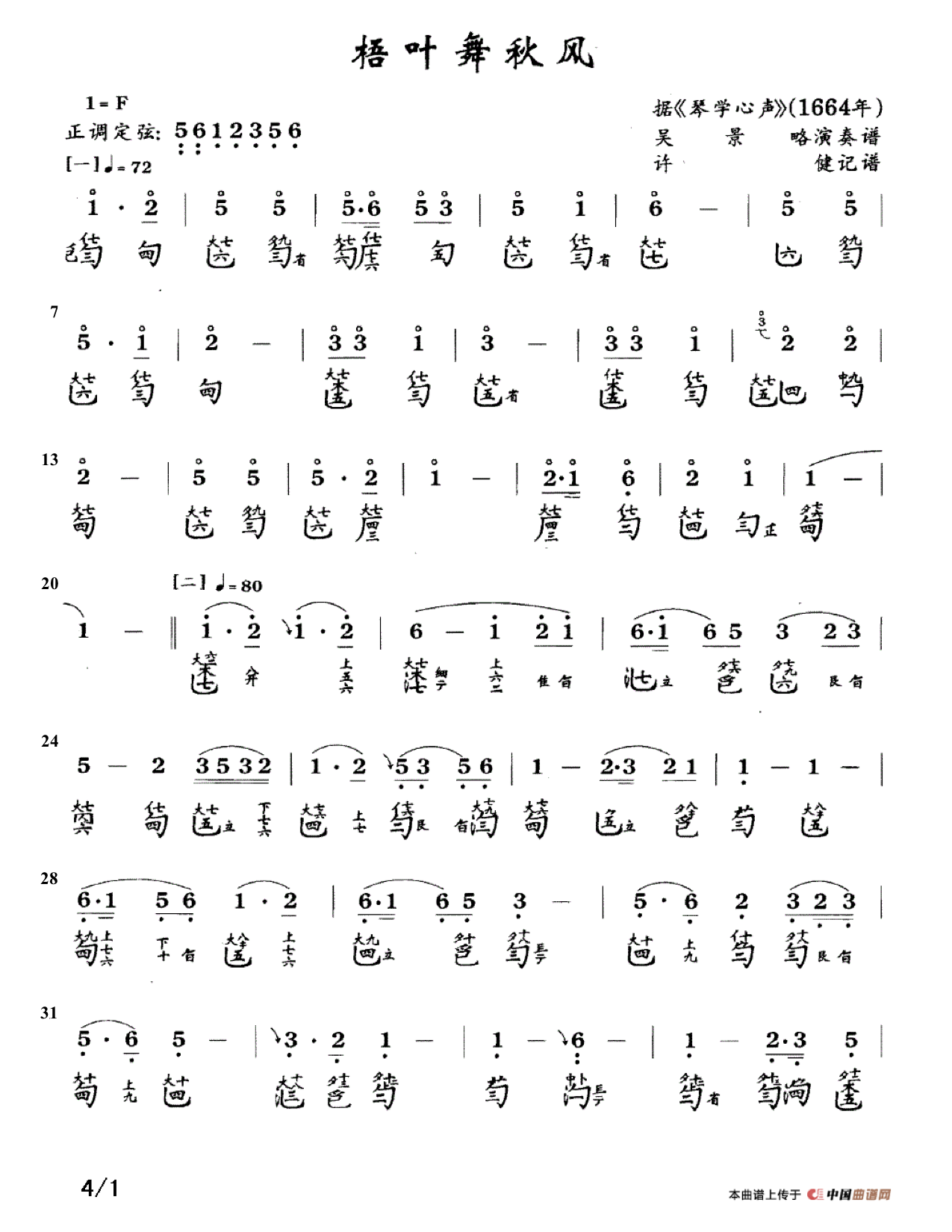
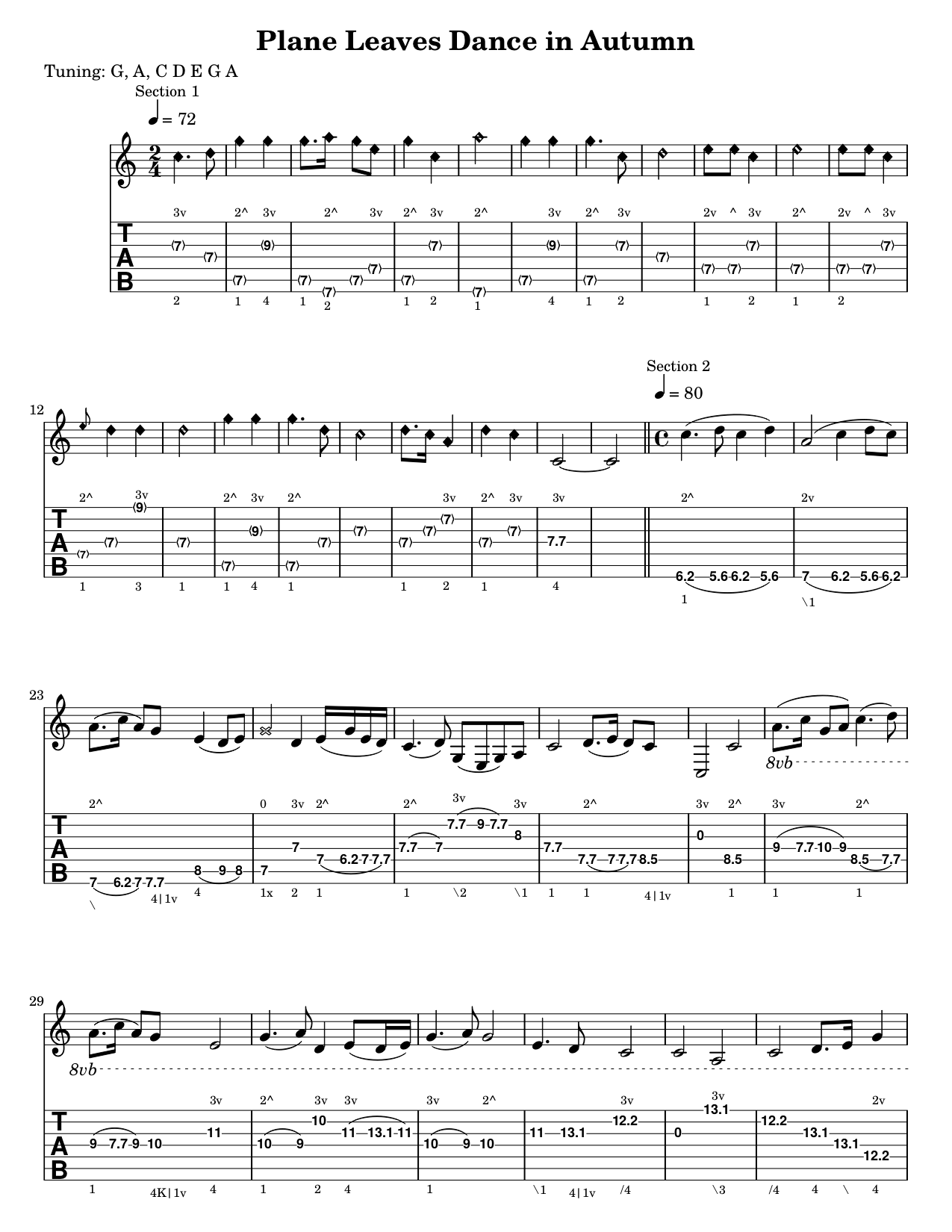
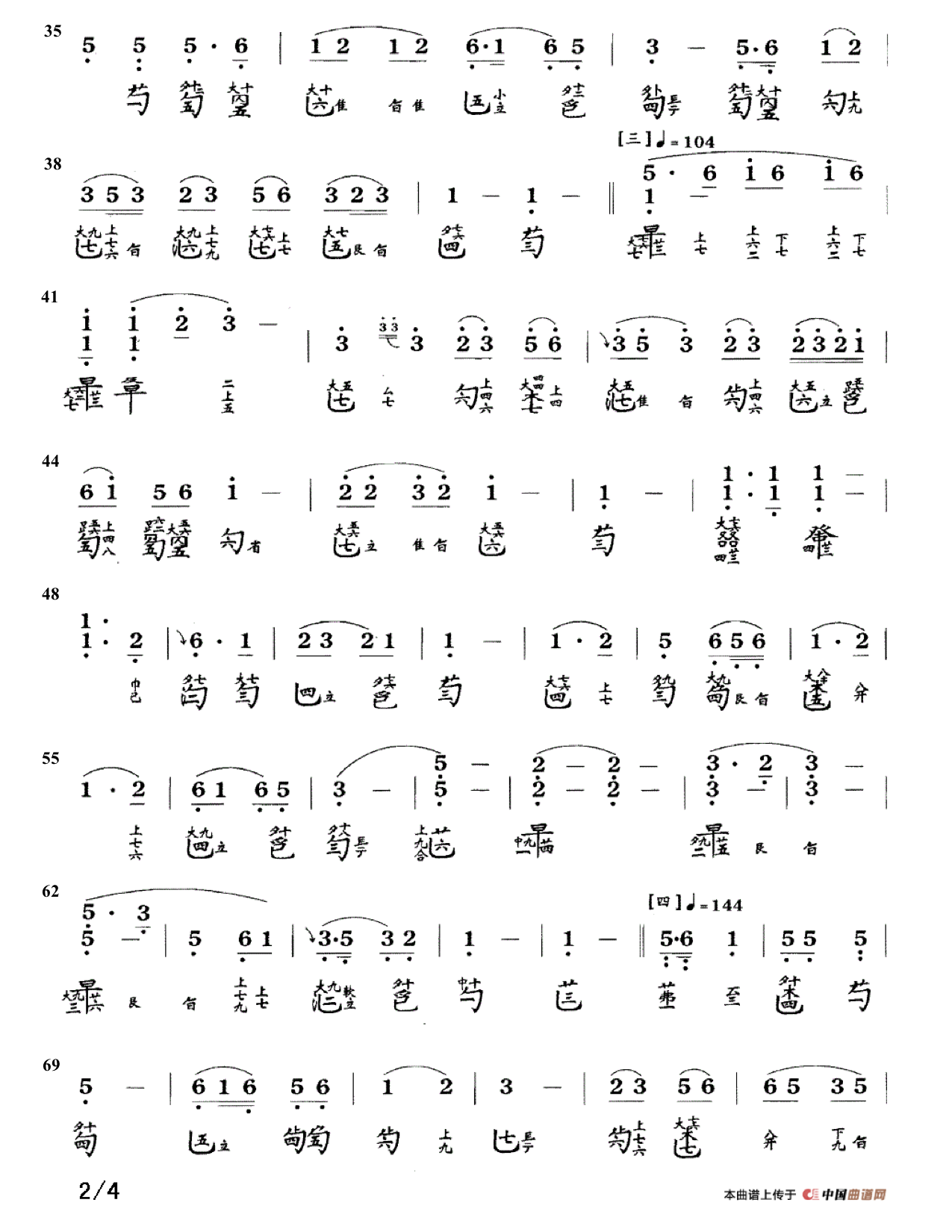
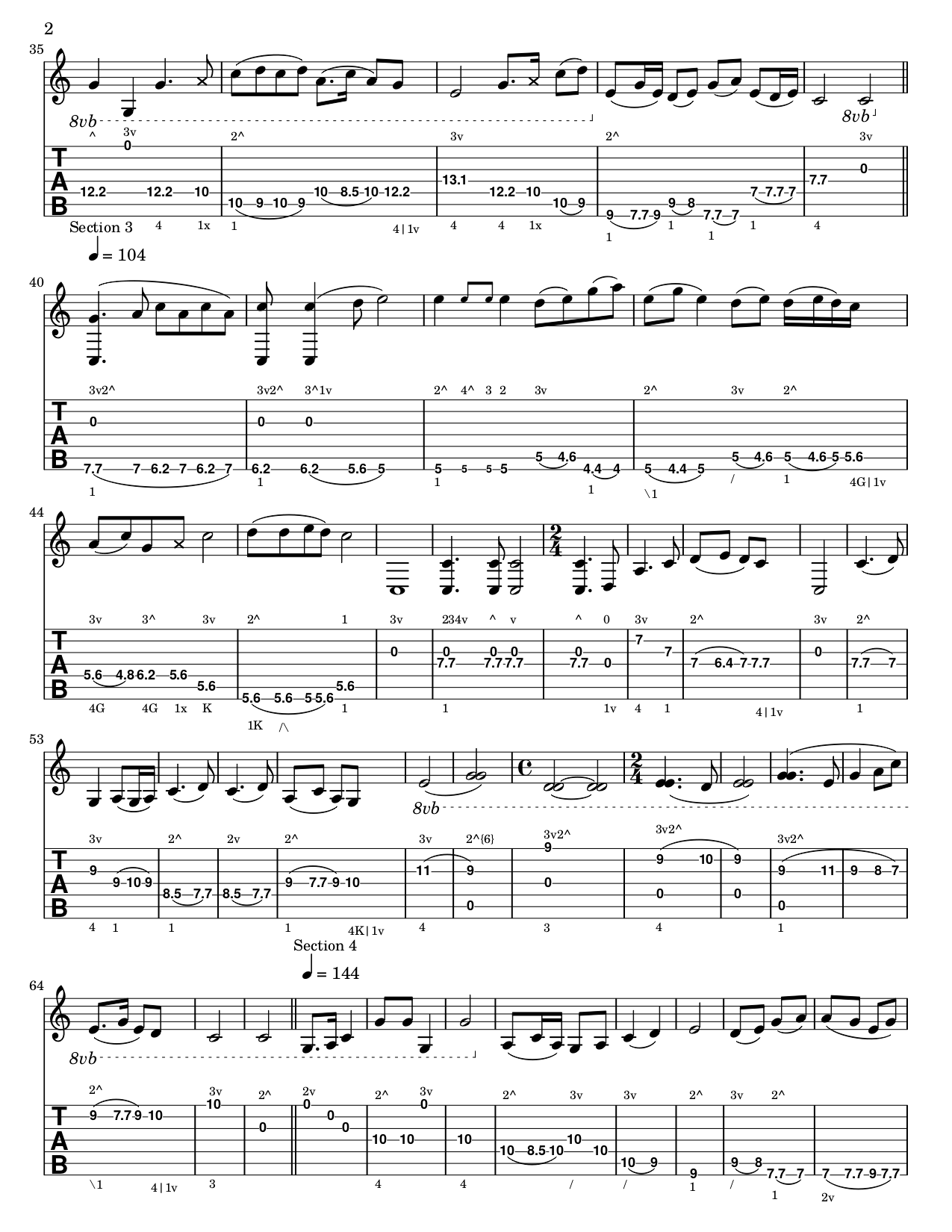
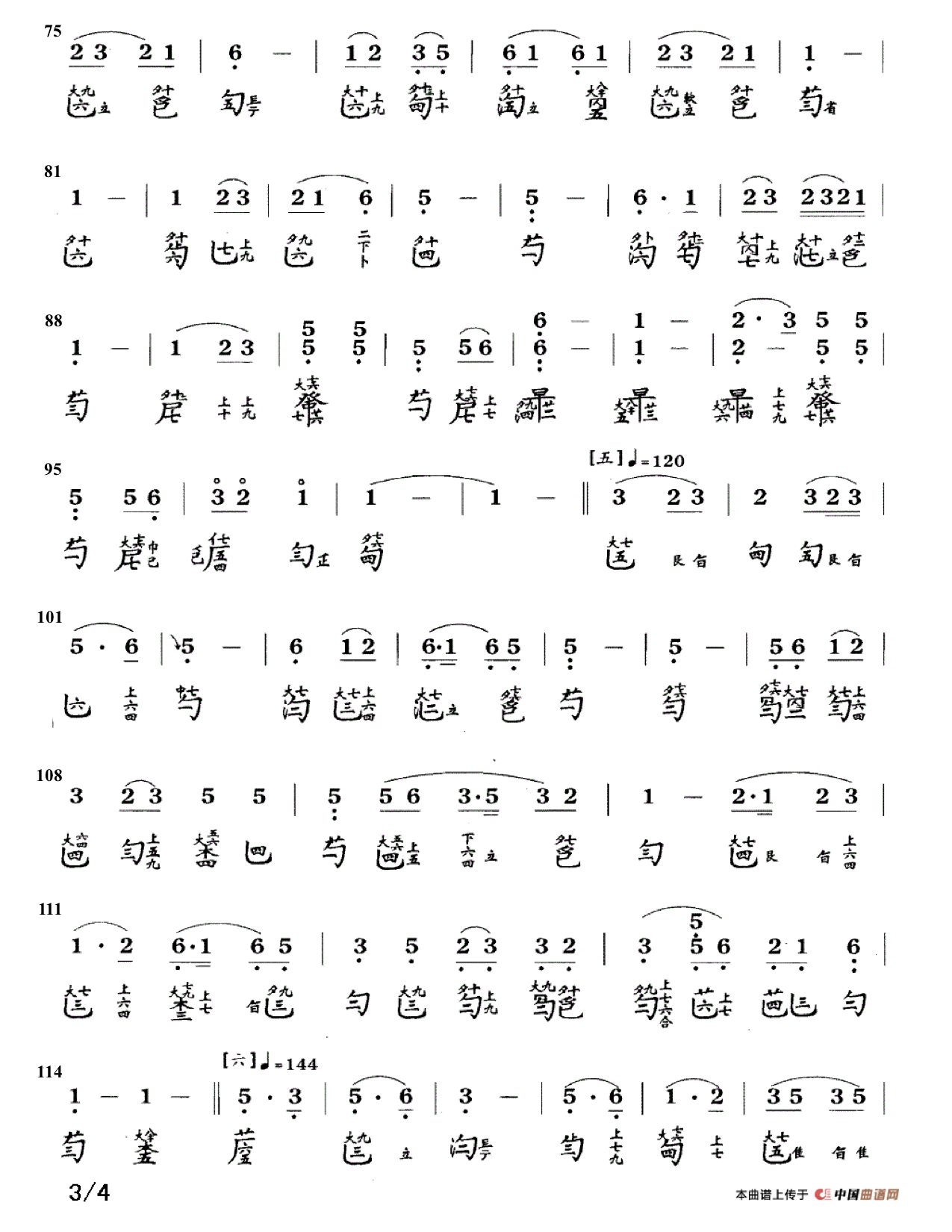
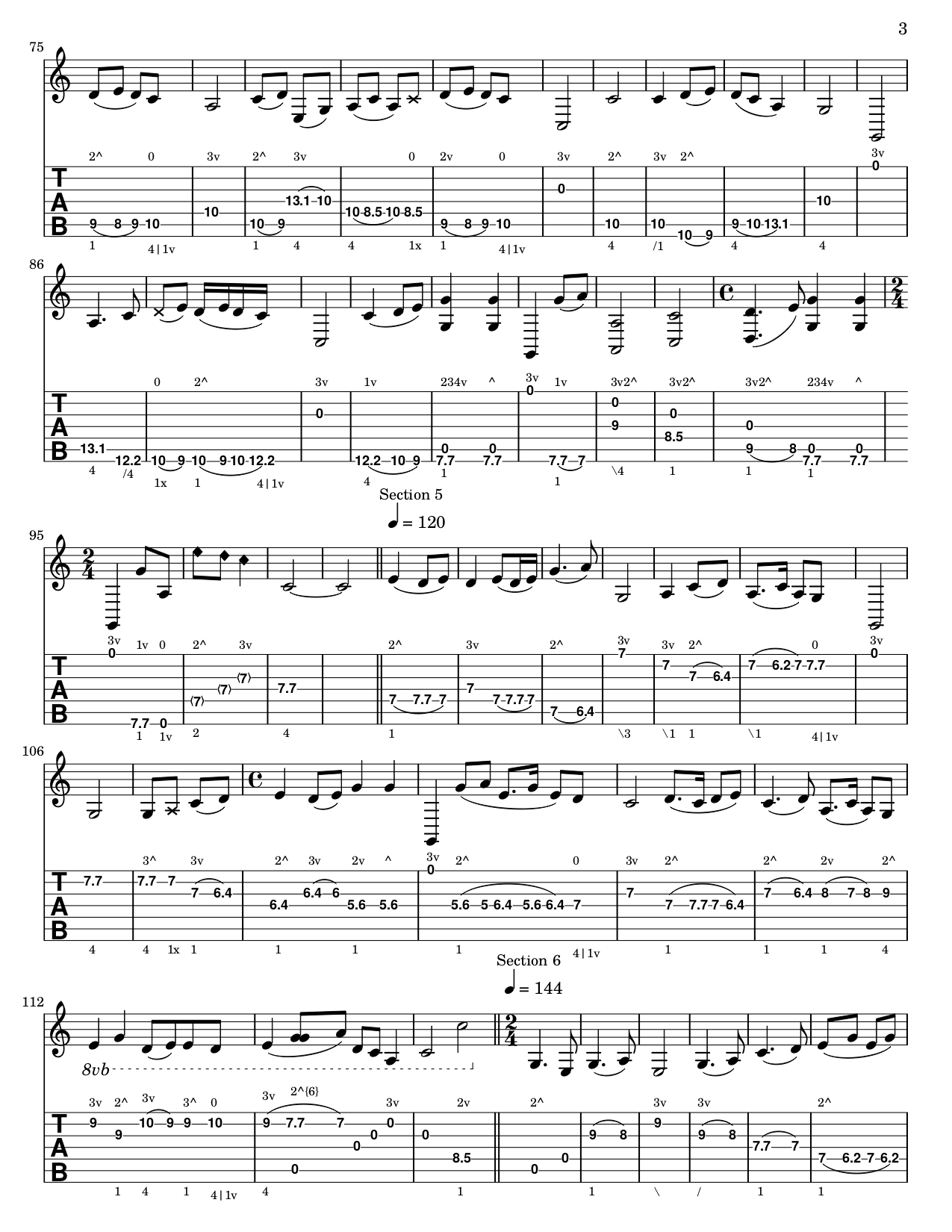
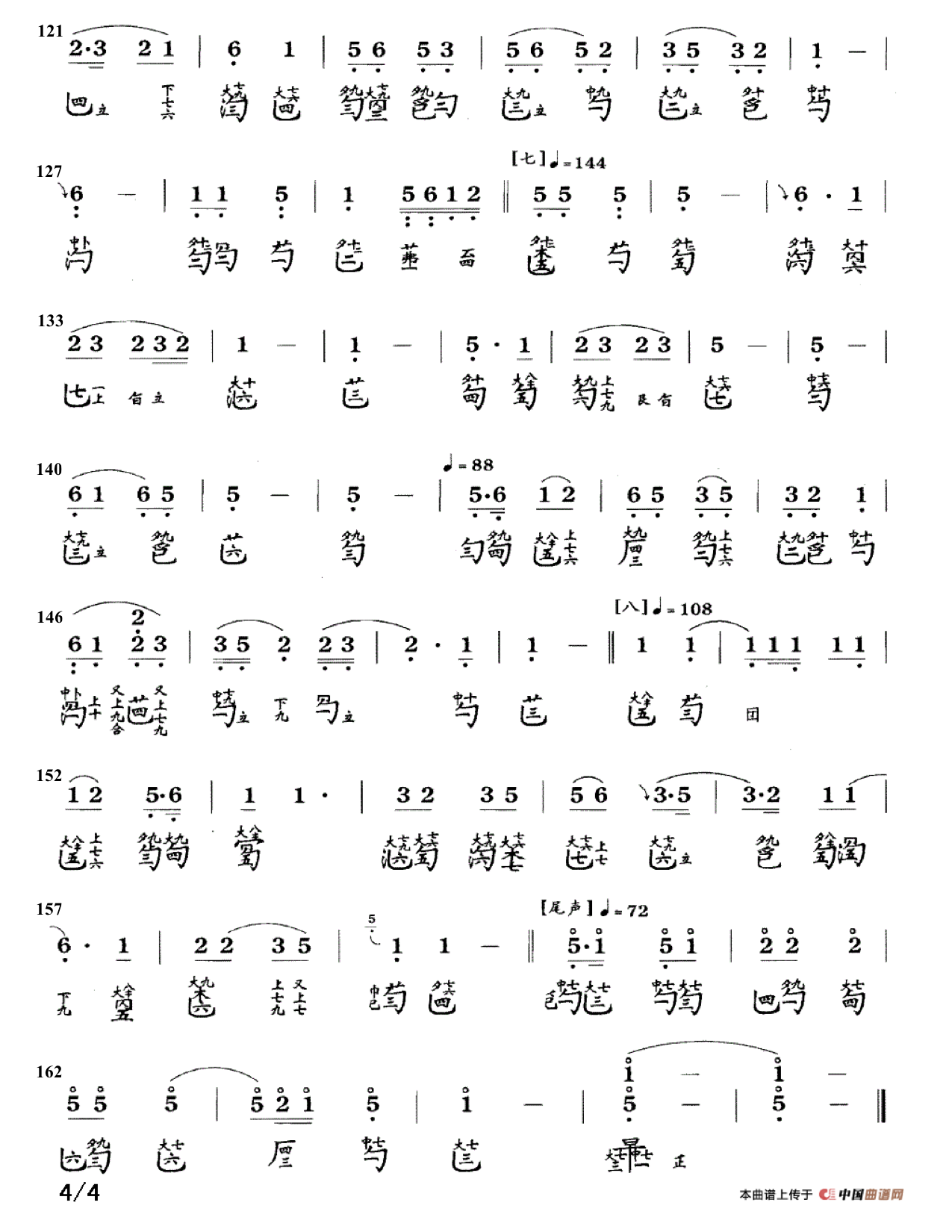
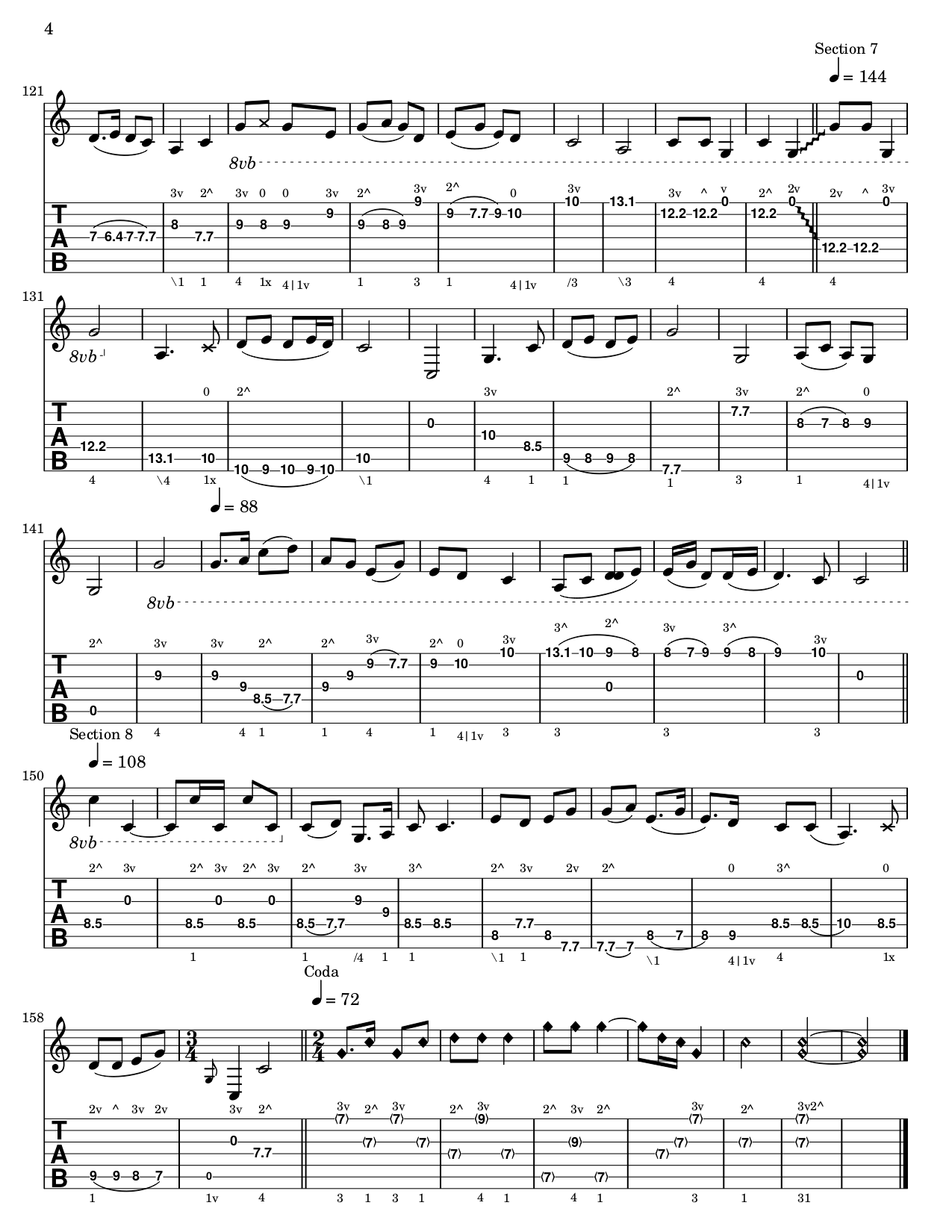
As an exercise to further test out NLTabs, I might score a new piece in NLTabs and learn it that way. I wonder if it will be easier for me to learn new pieces that way.
5: LilyPond
One of the reason I invented a new tablature system is so I can write music for the Guqin. To write music, I use LilyPond. It has some cool features like being able to generate the hui number based on the note and string to use. It does take a little bit of hacking to get it to display the things I want to display though. But I did have two weeks of "vacation" time, which during COVID in the middle of Seattle's rainy season, means sitting at home programming LilyPond.
REFERENCE: Guqin Template for NLTabs I use to start new projects.
This is hosted on LilyBin, which enables people to write music using the LilyPond interpreter without downloading anything. The template has some basic notations and custom Guqin-specific functions. To use this, edit the song variable, in the template there are examples starting at line 94.
So this text input:
c'4 d' e' f'Produces this:

The 4 after the c denotes the note length (quarter note or 1/4), with all subsequent notes following suit. The ' after the c denotes the octave.
Embellishments for each note:
\1for first string, etc.^"foo"to annotate above the note with foo_"foo"to annotate below the note with foo<note note>to make a chord\grace noteto make the note a grace note\fy noteis a custom function I made to convert the note into a fan yin, or harmonic\lmis a left hand mute function, which generates the X shaped notes indicating a mute
So as an example using the embellishments above, this code block:
a4\7^"1v"_"1~~"
\fy a''2\7^"3v"_"3"
\grace <a\7 g\6>8^"234v" <a\7 g\6>4\7^"^"
... produces this:

All the music on this post is generated using LilyPond. It's quite powerful and hackable. And it's free.
The Guqin Template I use is linked here, this template contains a few sample passages that illustrates how to use all the LilyPond features to generate NLTabs.
6: Concluding Thoughts on NLTabs
Having used NLTabs to transcribe and re-learn one of my favorite Guqin pieces and to write some of my own pieces, I am quite happy with this notation system.
- Tried and true (and thus lots of stealable ideas): NLTabs are something the guitar community have used for years and years (actually, centuries and centuries). It has the benefit of years of user testing and refinement. How should I write a "mute" action? There are conventions for dealing with that. So I don't need to invent a lot of things and get it wrong.
- Easier to read: (a) NLTab are visually similar to the strings on the instrument, so just glancing at the tabs we have a visual indication of the plucking pattern. It's just much quicker and easier to understand. (b) I use a dozen or so concepts, and I'm able to combine them to express more complex combinations of techniques. This means I need to memorize less symbols to "sound out" playing techniques. (c) I can better visualize how to play the song by looking at the tabs. I can browse just the right handed fingerings to think about whether the combos looks natural, and same with the left hand.
- Use computer to write notation (& ASCII friendly): I can use LilyPond (which is free) to write music for the Guqin. And in a pinch, I can even use Notepad (well, Sublime Text obvs.). For me, it's important to do this on the computer and not with paper/pencil because I edit and delete, add and remove all the time. Versioning is nice.
- Optional fingering: One of the simplifications employed here is making some fingering instructions optional. This means I write less, but also visually it's a bit less cluttered. Also, it leaves a bit more up to the artist to come up with clever techniques, which is nice.
- Multiple voices: This method lends itself to writing music for multiple voices (e.g., melody, counterpoints, accompaniments) more readily. We can have one line with the melody and another with the bass line. Using NLTabs, it's often pretty obvious to see which is which as well. Having played the piano my whole life, just playing the melody without a bass accompaniment line just seems... empty. An example of this comes in the next section, where I go into a song I arranged using the NLTab system.
Oh. Multiple voices. We haven't really touched on that. I'll go into that more deeply at some future point. Stay tuned!
Next up, Part 4: JianZiPu Font
Other parts in the Guqin series:
Intro | Part 1 | Part 2| Part 3 | Part 4 | Coda (TLDR & links)